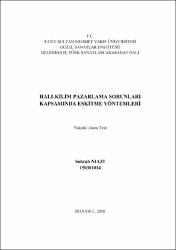| dc.contributor.advisor | Uğurlu, Aydın | |
| dc.contributor.author | Niazi, Sohrab | |
| dc.date.accessioned | 2018-04-25T07:55:38Z | |
| dc.date.available | 2018-04-25T07:55:38Z | |
| dc.date.issued | 2018 | |
| dc.date.submitted | 2018 | |
| dc.identifier.citation | NİAZİ, Sohrab, Halı-kilim pazarlama sorunları kapsamında eskitme yöntemleri, Fatih Sultan Mehmet Vakıf Üniversitesi Güzel Sanatlar Enstitüsü Geleneksel Türk Sanatları Anasanat Dalı, Yayımlanmamış Yüksek Lisans Tezi, İstanbul 2018 | en_US |
| dc.identifier.uri | https://hdl.handle.net/11352/2700 | |
| dc.description.abstract | Tekstil ürünleri içinde çok önemli bir yere sahip olan halı, ihtiyaçlardan dolayı
ortaya çıkmış olup, ilk çağlardan bu yana insanoğlunun kültür tarihiyle birlikte
gelişimini sürdürmüş ve en önemli uğraşlardan biri olmuştur. Zengin bir alt yapıya
sahip olan geleneksel halı dokumalar, günümüzde çağdaş sanat içinde yerini almıştır.
Orta Asya’dan çıkmış olan Pazırık halısı, göçebe kültürün en büyük mirasıdır.
Yerleşik hayata geçilmesiyle birlikte evlerin, sarayların, köşklerin zeminlerinde ve
duvarlarında kullanılmıştır. Coğrafi konum, iklim, sosyo-ekonomi ve kültür etkisine
göre halı; üretim tekniği, malzeme ve desen farklılıkları olsa da temel özellikleri hep
aynı kalmıştır.
Selçuklu Türkleri bu sanatı Orta Asya’dan Anadolu’ya taşıyıp, devam ederek
geliştirdiler. Osmanlı döneminde halı sanatı Türkiye’nin birçok bölgelerinde özellikle
Gördes, Kula, Isparta, Konya, Hereke ve Çanakkale de dokuma sanatı devam etmiştir.
19. yüzyılda İngilizlerin, Anadolu’da halı dokuma şirketlerini kurduktan sonra
Türk halı sanatında yeni bir dönem başlatmışlar. Kök boyalar yerine, kimyasal boyalar
kullandılar, motifleri farklılık gösterdi, boyutlarını değiştirdiler. Sonuçta Türk halı
kültürünü, kendi istekleri doğrultusunda değiştirdiler1.
Diğer yanda 20. yüzyılda halının endüstriyel bir ürün haline gelmesi, dokuma
halıların satışında gerileme ve düşüşe sebep oldu, bu yüzden halı tüccarları eskitme
yöntemleriyle halı sektörünü yeniden canlandırmaya çalıştılar.
“Halı-Kilim Pazarlama Kapsamında Eskitme Yöntemleri” konulu tezimin
çalışması dört temel bölümden oluşmaktadır:
Birinci bölümde, Türk halı sanatına genel bakış, açıklanmıştır.
İkinci bölümde, kirkitli dokumaların yıkanması incelenmiştir.
Üçüncü bölümde, kirkitli dokumalarda eskitme yöntemleri araştırılmıştır.
Tezimin dördüncü bölümde, kirkitli dokumalarda eskitme yöntemler ile sanatsal
deneylere dönüştürülmesi yer almaktadır. | en_US |
| dc.description.abstract | Carpet, which has a key position among textile products, has come into existence
as a consequence of needs, it has continued its development along with the history of
culture of humankind, starting from the ancient times and has been one of the most
significant occupations. Traditional carpet weaving, which has a rich infrastructure, has
taken its place among contemporary arts today.
Pazyryk carpet, which originated from Central Asia, is the biggest heritage of the
nomadic culture. Following the transition to settled life, it has been used on the floors
and walls of houses, palaces and mansions. Despite the variations in the production
techniques, materials and designs, depending on geographical location, climate,
socioeconomic status and culture, its basic features have remained the same.
Seljuk Turks have brought this art from Central Asia to Anatolia, they continued
with it and developed it. The carpet art present during the Ottoman Era has continued as
weaving arts in many parts of Turkey, especially in Gordes, Kula, Isparta, Konya,
Hereke and Canakkale.
After the British established carpet weaving companies in Anatolia during the 19th
century, they started a new era in the Turkish carpet art. They used chemical dyes
instead of root dyes and the motives were different and they changed the dimensions.
As a consequence, they changed the Turkish carpet culture according to their own
wish2.
On the other hand, the fact that carpets became an industrial product in the 20th
century, led to a decline and decrease in the sales of woven carpet, therefore, carpet
merchants tried to revive the carpet sector with wearing methods.
The studies conducted for my thesis with subject “Wearing Methods Within the
Scope of Carpet-Rug Marketing” comprises of four basic parts:
A general overview to the Turkish carpet art has been explained in the first part.
Washing of weavings with carpet loom (with korkit) have been examined in the
second part.
Wearing methods of weavings with carpet loom (with korkit) have been
researched in part three.
The fourth part of my thesis comprises of transforming weavings with carpet loom
(with korkit) into artistic experiments with wearing methods. | en_US |
| dc.language.iso | tur | en_US |
| dc.publisher | Fatih Sultan Mehmet Vakıf Üniversitesi, Güzel Sanatlar Enstitüsü | en_US |
| dc.rights | info:eu-repo/semantics/openAccess | en_US |
| dc.subject | Halı | en_US |
| dc.subject | Kilim | en_US |
| dc.subject | Eskitme | en_US |
| dc.subject | Kirkitli | en_US |
| dc.subject | Tekstil | en_US |
| dc.subject | Carpet | en_US |
| dc.subject | Rug | en_US |
| dc.subject | Wearing | en_US |
| dc.subject | With Carpet Loom (With Korkit) | en_US |
| dc.subject | Textile | en_US |
| dc.title | Halı-kilim pazarlama sorunları kapsamında eskitme yöntemleri | en_US |
| dc.type | masterThesis | en_US |
| dc.contributor.department | FSM Vakıf Üniversitesi, Güzel Sanatlar Enstitüsü | en_US |
| dc.relation.publicationcategory | Tez | en_US |
| dc.contributor.institutionauthor | Niazi, Sohrab | |



















